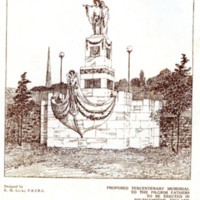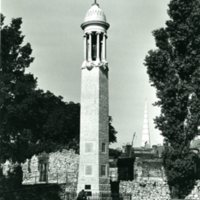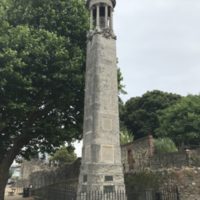Description
Southampton’s most elaborate monument to the Mayflower voyage was erected in 1913. Standing on the Western Esplanade, chosen to be as near as possible to the point of departure, it consists of a Portland stone square column that rises fifty feet from a stepped base, tapering slightly at the end. A white and gold glass mosaic cupola, supported by eight columns, sits on top, crowned by a copper Mayflower weather-vane. On every second column there are carved corbels: three female heads, representing Faith, Hope and Charity; and the prow of a ship, facing the sea. Original inscriptions were to the ‘little company of Pilgrim Fathers who were destined to be the founders of the New England states of America’, and individual pilgrims such as John Alden and William Brewster.
The leading promoter of the scheme to raise the necessary money was Fossey John Cobb Hearnshaw, a notable Birmingham-born historian who specialised in medieval history. After moving to take up a professorial post at Southampton’s University College in 1900, he had published many books on Southampton’s local history, and believed that interest in the local past was a way to promote civic pride in the present. He was also a nonconformist, a supporter of the British Empire, and an enthusiast for closer links with the growing power of the USA – which he traced all the way back to the Anglo-Saxons that had lived in Wessex. The Mayflower pulled all these interests together: it was a symbolic link between Britain and the USA; the Pilgrims had been nonconformists; and it was an international story that had local origins. As he put it in 1910, ‘to have given shelter to the Mayflower for a fortnight during the course of that memorable voyage is an honour of which Southampton has good reason to be proud.’
The Memorial cost £600, money that was raised through public donations from well-wishers in both Britain and the USA. Not everyone was thrilled with the prospect for a monument to the Pilgrim Fathers, however: some thought it was a waste of money; others saw the Pilgrims as irrelevant to modern Southampton; and a few, such as the local antiquary Charles Cooksey, questioned the celebration of ‘unpatriotic’ and ‘murdering rascals’ who abandoned the country of their birth and went on to oppress other religious groups. When the memorial was revealed to the public the mood calmed down, and there was an ‘undenominational’ civic service where the great and the good – such as the Lord Bishop of Winchester and the American Ambassador (Walter Hines Page) – celebrated the shared heritage between Britain and the USA that the monument symbolised.
Other plaques have been attached to the monument in the decades following. In 1955, for example, a special return pilgrimage of 104 American Pilgrim descendants (plus 48 guests) toured Holland and England to visit the birthplaces, churches and departure points of their ancestors. Led by the Governor-General of the General Society of Mayflower Descendants, Society, Lieutenant-Colonel Waldo Morgan Allen, they came ‘in the name of Anglo-American friendship’ and to perpetuate the memory of the Pilgrim Fathers. On the monument, as part of this trip, they gifted and unveiled a bronze plaque – embossed with the Mayflower – to mark the occasion.
For more information, see Tom Hulme, ‘Memories of the Mayflower in Southampton’, Hampshire Notes (2020).




